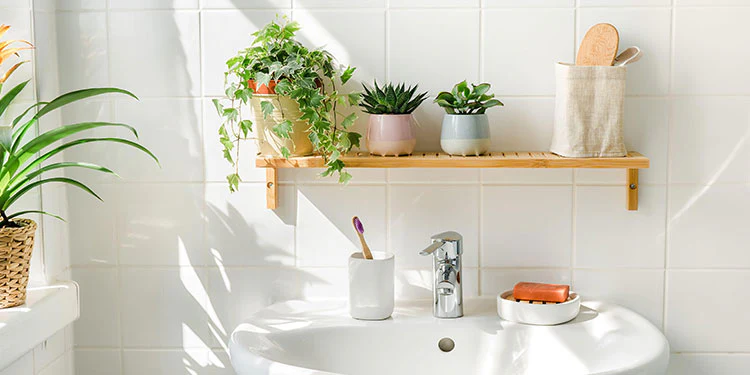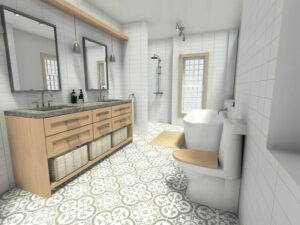Last winter, after a long day at work, Jessica collapsed onto her couch with a cup of tea. As she scrolled through Pinterest for home décor inspiration, something caught her eye—an image of a bathroom that looked more like a tropical oasis. The room was filled with lush greenery, vines cascading from the ceiling, and small potted plants perched on shelves and the windowsill. It was stunning. The bathroom, usually just a functional space in Jessica’s home, could be transformed into a soothing, spa-like retreat. That night, she decided to bring nature into her home, starting with her bathroom. Little did she know that adding plants to a humid, often overlooked room would elevate its style and improve the air quality and her overall well-being.
In this article, we’ll dive into the beautiful world of bathroom plants, explaining why they thrive in such a unique environment and which ones are best suited for the job. We’ll also explore the health benefits of having plants in your bathroom, provide some stats on plant ownership trends, and explain how to care for these botanical beauties so that they flourish in your space.
Why Bathrooms Are Perfect for Plants
At first glance, the bathroom might not seem ideal for plants. After all, it’s usually one of the smallest rooms in the house, with limited sunlight and fluctuating humidity. However, some plants thrive in these conditions as long as they’re chosen carefully.
- High Humidity is a Plus
Many houseplants, particularly tropical species, love moisture and humidity, and few rooms in a home offer a more humid environment than the bathroom. This makes it the perfect spot for plants like ferns, orchids, and peace lilies, which naturally thrive in tropical, misty conditions.
According to Gardener’s Supply Company, plants that thrive in environments with humidity levels between 50% and 80% will do well in a bathroom. When you shower, the steam creates the perfect moisture level for these humidity-loving plants, keeping their leaves hydrated and lush.
- Air Quality and Wellness
Numerous studies show that indoor plants can help purify the air by removing toxins like formaldehyde, benzene, and ammonia from everyday household products. A NASA study on indoor air quality showed that plants like spider plants and peace lilies are particularly effective at filtering harmful chemicals. Imagine transforming your bathroom into a natural air purifier that looks beautiful and improves your health.
Another benefit is stress reduction. According to a study from Texas A&M University, plants can help reduce stress and anxiety. Adding greenery to your bathroom may offer a subtle but powerful way to enhance your relaxation, turning an everyday shower or bath into a calming experience. For Jessica, those morning showers became an opportunity to feel grounded amidst the chaos of daily life, all thanks to a few well-chosen plants.
The Best Bathroom Plants: Choosing the Right Ones
Not all plants are suitable for bathroom conditions. The key is to select species that can tolerate low to moderate light and high humidity. Here are some of the top plants that will thrive in your bathroom.
- Spider Plant (Chlorophytum comosum)
The spider plant is a resilient, low-maintenance plant that’s perfect for bathrooms. It tolerates low light conditions and loves the moisture in the air, making it an ideal candidate for hanging baskets or perched on a shelf. It’s also a champion at removing toxins from the air, as the NASA Clean Air Study proves. Plus, spider plants reproduce quickly, so if you’re successful with one, you’ll soon have “baby” spider plants to place around the rest of your home.
- Aloe Vera (Aloe barbadensis)
Aloe vera isn’t just an excellent plant for bathroom décor—it’s also beneficial. Aloe plants thrive in bright, indirect light, and the humidity from your showers can help them retain moisture. Best of all, the gel from an aloe vera plant can be used to treat minor burns and skin irritations, making it a practical plant to have on hand in a space where you may need quick skincare relief.
- Snake Plant (Sansevieria trifasciata)
The snake plant, also known as the mother-in-law’s tongue, is nearly indestructible. It tolerates low light and high humidity and doesn’t need frequent watering. Snake plants are also excellent air purifiers, helping remove pollutants like formaldehyde and benzene, often found in personal care products like hairspray and shaving cream.
- Peace Lily (Spathiphyllum)
The peace lily is another tropical plant that thrives in low-light and humid environments, making it ideal for bathrooms. In addition to its elegant, white blooms, the peace lily helps filter mold spores from the air, a crucial benefit in damp spaces like bathrooms. According to the Environmental Protection Agency (EPA), bathrooms are one of the most common places for mold growth, making the peace lily beautiful and functional.
- Boston Fern (Nephrolepis exaltata)
Boston ferns love humidity, making them perfect for bathrooms with regular shower steam. They prefer indirect light and can tolerate some low-light conditions, making them versatile for various bathroom layouts. Additionally, Boston ferns are well-known for their air-purifying properties, especially when removing formaldehyde from the air.
Caring for Bathroom Plants: Tips for Success
Once you’ve chosen your plants, caring for them properly is essential to ensure they thrive. Here are some tips to help your bathroom plants stay healthy and vibrant.
- Pay Attention to Light Levels
While bathrooms tend to be more humid than other rooms in the house, they may also have limited natural light. If your bathroom has a window, choose plants that enjoy indirect sunlight. But if your bathroom lacks natural light, opt for plants like snake plants or philodendrons, which can survive in low light. Consider installing LED grow lights to supplement your plants’ light intake.
- Water Sparingly
Although bathrooms are humid, most plants still need to be watered occasionally. Make sure to check the soil’s moisture level regularly. Some plants, like succulents or aloe vera, require minimal watering because they store water in their leaves. Overwatering is one of the most common mistakes made by plant owners, so be careful not to drown your green companions.
- Ventilation is Key
Despite bathroom humidity, proper ventilation is still crucial for plants to avoid mold and mildew growth. If your bathroom has no window, use the ventilation fan or leave the door open after a hot shower to allow some fresh air in. A fan or vent will also help circulate the air, preventing your plants from becoming too waterlogged.
- Rotate Your Plants
To ensure your plants receive equal amounts of light and don’t grow lopsided, rotate them every few weeks. This will allow all sides of the plant to benefit from the available light source and grow evenly.
The Health Benefits of Indoor Plants in Bathrooms
Having plants in your bathroom goes beyond just adding visual appeal. Science supports several health benefits associated with indoor plants.
- Air Purification: Studies from NASA and the American Lung Association have shown that plants like peace lilies and snake plants can absorb pollutants, improving indoor air quality. Bathrooms are often filled with chemical pollutants from cleaning products and personal care items, and having plants can reduce the harmful effects of these chemicals.
- Mental Health Benefits: A study from the Journal of Physiological Anthropology found that interacting with indoor plants can reduce psychological and physiological stress. Greenery in your bathroom can improve your mood and make your bathroom feel like a spa retreat.
- Reduced Noise Levels: Plants can also help reduce noise levels in your home by absorbing sound. This is particularly useful in small, tiled bathrooms, where sound tends to bounce around. Adding a few large-leaf plants can soften the acoustics and create a more tranquil atmosphere.
The Growing Trend of Houseplants in Bathrooms
The popularity of houseplants has exploded in recent years, and this trend shows no signs of slowing down. According to a report by Gardening Insights, 66% of millennials in the U.S. consider themselves “plant parents,” with indoor plant sales increasing by 50% from 2016 to 2021. Once overlooked in interior design, bathrooms have become focal points for incorporating nature into daily living spaces.
Many Instagram influencers and home décor bloggers have capitalized on this trend, showcasing stunning bathroom plant setups that have inspired people worldwide to bring the outdoors in. Plants like monstera, pothos, and even small trees like the fiddle leaf fig are being integrated into bathrooms to create lush green spaces.
Conclusion: Transform Your Bathroom with Plants
Plants can transform a dull, sterile bathroom into a peaceful, inviting space. Whether you choose easy-care plants like snake plants and aloe vera or more decorative options like ferns and orchids, you’ll be adding beauty, better air quality, and a touch of serenity to one of the most functional rooms in your home. Jessica’s bathroom, once just a place to get ready for the day, became her private sanctuary to relax and reconnect with nature.
So, why not follow in her footsteps and turn your bathroom into a green haven? With the right plants and care, your bathroom could soon become the most serene room in the house.






